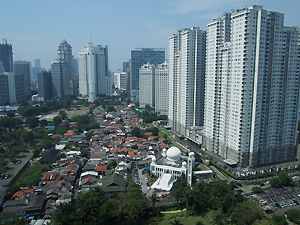Top>Opinion>Learning from Southeast Asia
 Index
Index

Hisanori Kato【profile】
Learning from Southeast Asia
Hisanori Kato
Professor, Faculty of Policy Studies, Chuo University
Areas of Specialization: Socio-religious anthropology, Southeast Asian studies, comparative civilizations
Not much separates Japan and Southeast Asia in terms of geography. Southeast Asia’s scenic resort districts, handicrafts, traditional dance, and traditional music are also popular with the Japanese people—many of whom surely take trips there. Prices are cheap, which makes it attractive to businesses looking to secure inexpensive labor for their production centers. Recent years have seen a rising Southeast Asian middle class, making the region a growing market for companies to sell their products as well. It is also a critical area from the standpoint of Japan’s international strategy, with public agencies providing Southeast Asia with numerous forms of assistance. Private non-governmental organizations are very active in the region as well.
Southeast Asia and Japan
Unfortunately, Japanese people tend to fall into the trap of looking down on Southeast Asians. On the whole, the people there hold a great deal of respect for Japan for pulling off such a miraculous economic recovery following the devastation of World War II. Malaysian Prime Minister Mahathir bin Mohamad’s famed “Look East Policy,” in which he urged his countrymen to look to Japan as an example, was enough to give the Japanese a full-blown superiority complex towards their neighbors to the southwest. That’s not to say that Japan doesn’t have much to be proud of in terms of its efficient systems and technology. Our country is in an entirely different league when it comes to the size of our economy. Should Southeast Asia take a page from Japan’s book, it would surely be a wonderful form of exchange. But that still leaves Japan stuck on a one-way street. We cannot adopt a new attitude if we feel we have simply done Southeast Asia a favor.
Recognizing the value of Southeast Asia
I have traveled extensively through Southeast Asia, and lived for quite a while in Indonesia and the Philippines. My seven-year station in Indonesia was particularly notable, as the time seemed to go by in the blink of an eye. Those experiences have taught me the value of Indonesia and other parts of the region, convincing me that Southeast Asia actually has something of tremendous benefit to offer to the rest of the world. That gift is the ability to live in harmony while preserving diversity, to take a flexible approach to things, and to live in harmony with the natural environment. People may have written off these abilities as primitive and uncivilized during the colonial period, but Southeast Asian ideas are growing in importance as advancing globalization drives the entire world to become ever more closely tied together. I call this idea local civilization. The Japanese in particular and the world in general could stand to learn a lot from Southeast Asia, given the reality that the world’s people, with all of their incredible diversity, have no choice but to learn to coexist. That realization should cause Japan to drop its superiority complex, and is exactly what will give rise to a true form of exchange—where Japan and Southeast Asia actually both learn from one another.
Diversity and religion in Indonesia

Indonesia is the largest country in Southeast Asia in terms of population and incredibly diverse with over 300 known ethnic groups. Its territory is comprised of some 17,000 islands whose combined area rivals the entire European continent in terms of size, making it well suited to its role as the powerhouse of the region. More than 80 percent of Indonesia’s 240 million people are Muslim, which also makes it the largest Islamic nation in the world. The country maintains itself as a secular republic, however, and there is abundant diversity within Indonesia’s Muslim community (umat) itself. Perhaps because of the activities of the Liberal Islam Network, formed by young moderates seeking to build a New Islam, there are also numerous fundamentalist groups in Indonesia pushing for the introduction of sharia (Islamic law).
Aside from the diversity of the umat, Indonesia is widely influenced by religious traditions predating the spread of Islam, namely Buddhism and Hinduism. The Borobudur Temple has been shown to be the world’s largest freestanding Buddhist structure and possibly the oldest. The island of Bali, a globally renowned tourist destination, has a thriving Hindu population and is nicknamed the Island of the Gods. With all of its different religious and ethnic groups living together, Indonesia is truly a microcosm for the rest of our planet.
The concept of tidak apa apa
The first phrase I learned when I went to live in Indonesia was tidak apa apa, which means “no problem.” The people of Thailand and Cambodia have a similar phrase, but the Indonesian tidak apa apa seems to have a kind of magical effect in the course of daily life. Still, it is one of the most puzzling phrases for non-Indonesians to understand. Late for an appointment? Tidak apa apa. You asked someone to do something and it didn’t get done? Tidak apa apa. You might dismiss it as just another example of the distinctive laid-back culture of the tropics. It can also be used to attack less cultured attitudes that do not make efficiency a priority.
After several years in Indonesia, however, I came to see tidak apa apa as an example of the wisdom that Indonesian people have accumulated in the course of their daily lives. Countless ethnic groups mean countless different customs and ways of life. Thinking your own group is superior to another is a recipe for conflict. But if we adopt an attitude that says, “you have your way of doing things, and that’s just fine,” we can at least avoid more overt clashes. The phrase asks us to open a dialogue, and to take our time reaching mutual understanding. This makes Indonesia a natural when it comes to diplomacy. When the families of Japanese citizens abducted by North Korea pleaded to be reunited, it was Indonesia who came to their aid. Of course, it would be troublesome if an important agreement is broken in Indonesia with tidak apa apa, but I hope we can continue learning what Indonesia has to offer in terms of strategies for effectively living in a world where so many different value systems exist side-by-side.
-
Hisanori Kato
Professor, Faculty of Policy Studies, Chuo University
Areas of Specialization: Socio-religious anthropology, Southeast Asian studies, comparative civilizations - Professor Kato was born in 1964, and spent the years 1990–2009 living abroad in countries that included the US, Indonesia, Australia, and the Philippines. He got his Master of Arts from the Faculty of Art, University of Sydney, followed by his Ph.D. He currently carries out fieldwork-based research primarily in Islam and the sociocultural climate of Indonesia. Professor Kato worked as an associate professor at the De La Salle University in the Philippines and a professor at National University in Indonesia and Osaka Butsuryo University before taking up his current post in April 2015. His primary works include Agama dan Peradaban (Religion and Culture) (PT Dian Rakyat, 2002) and Islam di Mata Orang Jepang (Islam from a Japanese Perspective) (Buku Kompas, 2014). He also co-edited The Clash of Ijtihad (ISPCK, 2011) and co-authored Civilization Studies in the Global Era (2) [Chikyu-jidai no Bunmeigaku (2)] (Kyoto Tsushinsha, 2011) and The Future of Civilization [Bunmei no Mirai] (Tokai University Press, 2014).
- Research Activities as a Member of Research Fellowship for Young Scientists (DC1), Japan Society for the Promotion of Science (JSPS) Shuma Tsurumi
- Important Factors for Innovation in Payment Services Nobuhiko Sugiura
- Beyond the Concepts of Fellow Citizens and Foreigners— To Achieve SDGs Goal 10 “Reduce Inequality Within and Among Countries” Rika Lee
- Diary of Struggles in Cambodia Fumie Fukuoka
- How Can We Measure Learning Ability?
—Analysis of a Competency Self-Assessment Questionnaire— Yu Saito / Yoko Neha - The Making of the Movie Kirakira Megane








